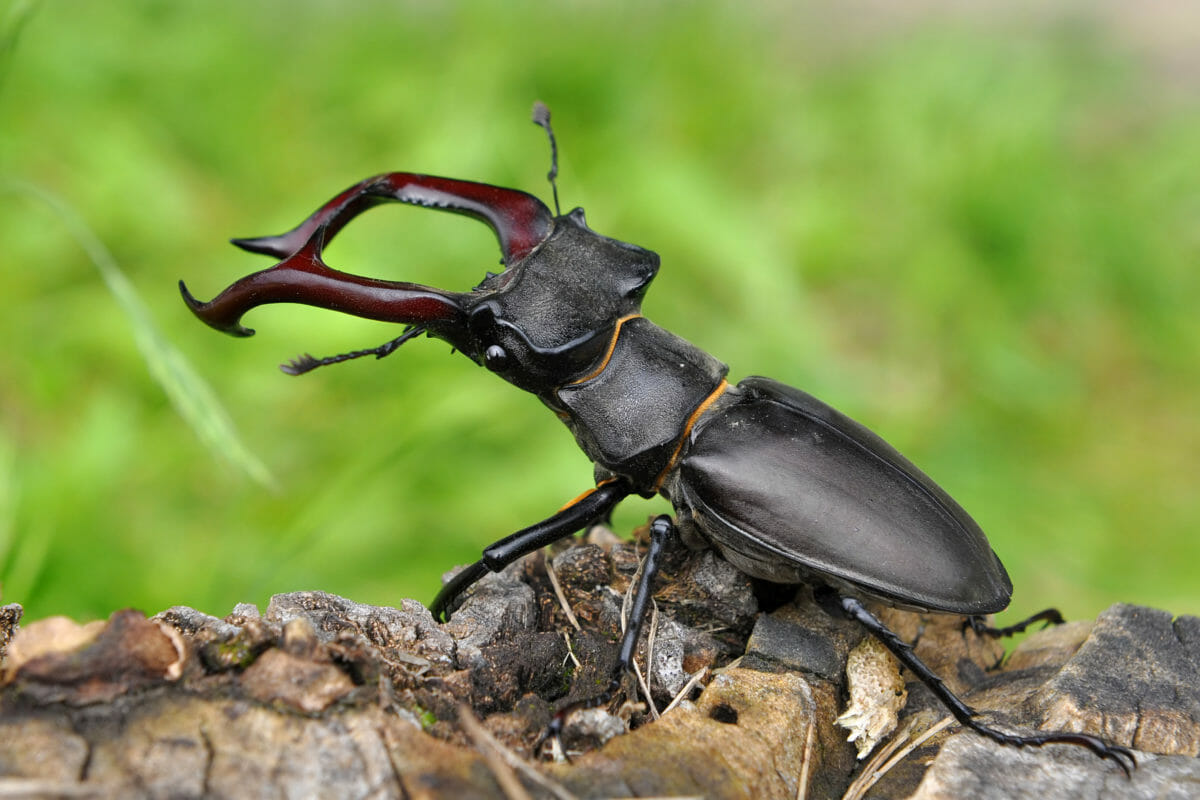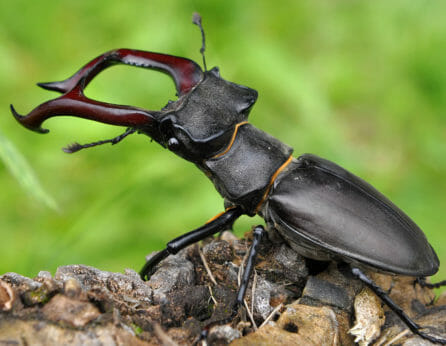Five Ways to Support Threatened Species in Your Garden
With a little help, your backyard can double as a tiny slice of the wild
Five Ways to Support Threatened Species in Your Garden
With a little help, your backyard can double as a tiny slice of the wild

The good news is that humans also have the ability to turn these artificial environments back into something that supports other species. Namely, through gardening.
Gardeners are forever obsessing over how to keep critters out, but there are plenty of critters that can be welcomed into the garden without causing havoc. Some actually perform useful services – bats and frogs excel at pest patrol, for example. Study up on the rare and endangered species in your part of the country and choose projects from the following list that will support the threatened birds, mammals, reptiles, amphibians, insects and plants in the ecosystem where you live.
Brush Pile
What could be easier? Designate an out-of-the-way corner of the yard as a place to pile up leaves and cut branches, which serve as habitat for many reptiles, mammals, birds, and insects.
Perhaps you’ll even attract the noble stag beetle, an enormous insect with fierce-looking (but harmless) pincers, which requires rotting wood to reproduce (and is endangered in some regions). Add to the top of the pile as often as you like, but otherwise, leave it in place and let it rot.

Butterfly and Hummingbird Garden
Both of these beautiful beings are extremely sensitive to habitat loss but easy to attract to the garden. Hummingbirds have coevolved with tubular-shaped flowers, like honeysuckle and salvia, for which their beaks are perfectly adapted to siphon nectar from; they are especially attracted to red and orange blossoms. Butterflies gravitate to large nectar-rich flower clusters, like those found on yarrow or milkweed (a favorite of monarchs), though many other plants, like such as rue and maypop, serve as host species for the larva of particular butterfly species.
Check which species of hummingbirds and butterflies are rare, threatened or endangered in your area and concentrate on the plants that are most attractive to each.
Bat, Bird and Bee Houses
You don’t have to be a master carpenter to hammer together a piece of bat, bird, or bee habitat – and there is good reason to do so: Bats and many birds eat pesky insects by the thousand and native bees (which, unlike honey bees, do not sting) are critical pollinators for native plants. You can even build a house for owls, which are masterful hunters of rodents.
If the conservation of threatened species is your goal, be sure to find a design suitable for the winged ones that you wish to offer refuge.
With birdhouses, for example, the size of the entrance hole may be varied to discourage certain common birds, while encouraging others that you’d like to see more of. Native bee “hotels” are typically designed with accommodations for multiple bee species in a single structure. With bats, the color of the house makes a big difference – not because of the bats’ aesthetic preferences, but because dark-colored houses hold more of the sun’s warmth (better in cold climates), while light-colored ones reflect it (better in hot locales)

Wildlife Pond
Many gardeners dream of having a fancy (and expensive) water feature, but to satisfy the needs of wildlife you need little more than an overgrown mud puddle.
Simply dig a broad, shallow depression – six feet wide and one foot deep in the middle, with gently sloping sides, will do – and line it with a piece of polypropylene pond liner from your local garden center. Add sand, pebbles, gravel, and rocks of varying sizes, including a small boulder that sticks above the waterline, and place a log or two so that they overhang the edge of the pond. Buy a few potted reeds, sedges and any other aquatic species that you wish, nestling the pots down into the gravel – the plants will soon colonize much of the open water.
If any amphibians in the area are in need of a home, they will follow their nose to your water garden. You may soon find lizards suntanning on the log and turtles on the boulder. Dragonflies and other beneficial bugs will be zipping about the pond surface. If you succeed in attracting amphibians, they should keep mosquito larva in check, but if needed, you can contact your local agricultural extension office and request “mosquito fish” – little minnows that will take care of the problem.
Native Garden
It’s not just animals that lose their habitat as we pave over nature’s paradise. Native plant species are also disappearing at an alarming rate. And by introducing native plants to your garden, you’re creating the very definition of wildlife habitat, as all native animals have coevolved with, and are dependent on, certain plant species.
Garden centers around the country increasingly stock plants that are indigenous to the local landscape, and nurseries that offer exclusively native plants are springing up all the time. You might also try contacting your nearest native plant society, as these groups often host seasonal plant sales.
Native plants often have smaller flowers and less showy foliage than nursery specimens that have been bred to maximize aesthetic traits. The individual attractiveness of natives may be understated, but their beauty comes out when grouped – drifts of wildflowers interspersed with puffy grasses and punctuated by the occasional tree or shrub, for example. Plant them as a border around your garden, aiming for a naturalized look. You’ll soon find a menagerie of critters taking up residence, as nature intended.
Follow us

This work is licensed under a Creative Commons Attribution-NoDerivatives 4.0 International License.
Want to republish a Modern Farmer story?
We are happy for Modern Farmer stories to be shared, and encourage you to republish our articles for your audience. When doing so, we ask that you follow these guidelines:
Please credit us and our writers
For the author byline, please use “Author Name, Modern Farmer.” At the top of our stories, if on the web, please include this text and link: “This story was originally published by Modern Farmer.”
Please make sure to include a link back to either our home page or the article URL.
At the bottom of the story, please include the following text:
“Modern Farmer is a nonprofit initiative dedicated to raising awareness and catalyzing action at the intersection of food, agriculture, and society. Read more at <link>Modern Farmer</link>.”
Use our widget
We’d like to be able to track our stories, so we ask that if you republish our content, you do so using our widget (located on the left hand side of the article). The HTML code has a built-in tracker that tells us the data and domain where the story was published, as well as view counts.
Check the image requirements
It’s your responsibility to confirm you're licensed to republish images in our articles. Some images, such as those from commercial providers, don't allow their images to be republished without permission or payment. Copyright terms are generally listed in the image caption and attribution. You are welcome to omit our images or substitute with your own. Charts and interactive graphics follow the same rules.
Don’t change too much. Or, ask us first.
Articles must be republished in their entirety. It’s okay to change references to time (“today” to “yesterday”) or location (“Iowa City, IA” to “here”). But please keep everything else the same.
If you feel strongly that a more material edit needs to be made, get in touch with us at [email protected]. We’re happy to discuss it with the original author, but we must have prior approval for changes before publication.
Special cases
Extracts. You may run the first few lines or paragraphs of the article and then say: “Read the full article at Modern Farmer” with a link back to the original article.
Quotes. You may quote authors provided you include a link back to the article URL.
Translations. These require writer approval. To inquire about translation of a Modern Farmer article, contact us at [email protected]
Signed consent / copyright release forms. These are not required, provided you are following these guidelines.
Print. Articles can be republished in print under these same rules, with the exception that you do not need to include the links.
Tag us
When sharing the story on social media, please tag us using the following: - Twitter (@ModFarm) - Facebook (@ModernFarmerMedia) - Instagram (@modfarm)
Use our content respectfully
Modern Farmer is a nonprofit and as such we share our content for free and in good faith in order to reach new audiences. Respectfully,
No selling ads against our stories. It’s okay to put our stories on pages with ads.
Don’t republish our material wholesale, or automatically; you need to select stories to be republished individually.
You have no rights to sell, license, syndicate, or otherwise represent yourself as the authorized owner of our material to any third parties. This means that you cannot actively publish or submit our work for syndication to third party platforms or apps like Apple News or Google News. We understand that publishers cannot fully control when certain third parties automatically summarize or crawl content from publishers’ own sites.
Keep in touch
We want to hear from you if you love Modern Farmer content, have a collaboration idea, or anything else to share. As a nonprofit outlet, we work in service of our community and are always open to comments, feedback, and ideas. Contact us at [email protected].by Brian Barth, Modern Farmer
August 2, 2018
Modern Farmer Weekly
Solutions Hub
Innovations, ideas and inspiration. Actionable solutions for a resilient food system.
ExploreExplore other topics
Share With Us
We want to hear from Modern Farmer readers who have thoughtful commentary, actionable solutions, or helpful ideas to share.
SubmitNecessary cookies are absolutely essential for the website to function properly. This category only includes cookies that ensures basic functionalities and security features of the website. These cookies do not store any personal information.
Any cookies that may not be particularly necessary for the website to function and are used specifically to collect user personal data via analytics, ads, other embedded contents are termed as non-necessary cookies.
WE can’t make a real difference until the farmers stop using EXcessive amounts of pesticides ( herbicides, insecticides) on the plants and soil.